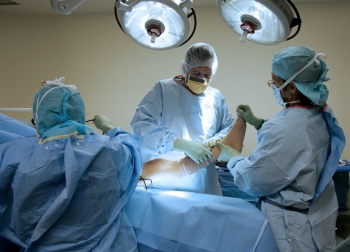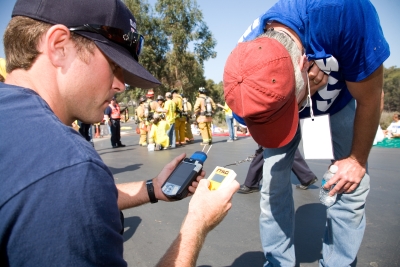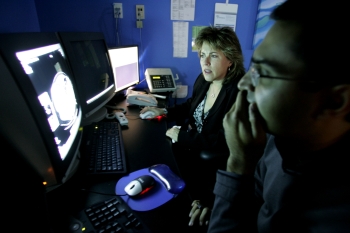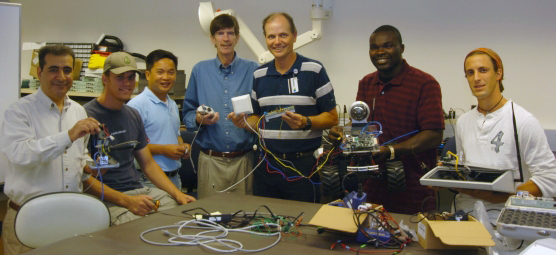Successful Kickoff for New Joint Initiative on Medical Device Development
|
San Diego, CA, January 18, 2007 -- In keeping with its tradition of fostering novel cross-disciplinary research collaborations, the UCSD division of Calit2 has become the home of the new Medical Device Affinity Group, a three-way initiative borne of Calit2, the UCSD School of Medicine's Department of Surgery and the Jacobs School of Engineering.
The goal of the Affinity Group is to create interdisciplinary collaborations to speed the development of new medical technologies. Although such joint endeavors might be expected to arise naturally, clinicians seldom have an opportunity to explore their ideas for new devices with the researchers and engineers who can actually create them. The Affinity Group is meant to provide precisely such opportunities.
To kick-off the joint initiative, Calit2 and the Department of Surgery organized the first large-group meeting at the UCSD Faculty Club on November 30, bringing together approximately 70 surgical clinicians and basic scientists, engineers and faculty from Calit2, Jacobs and other UCSD academic departments, to brainstorm about potential collaborations.
|
Roger Tsien, a professor of Pharmacology and Chemistry & Biochemistry, found the meeting very stimulating. He framed the core question that the Affinity Group was created to address: "What new problems would I like to attack if I could find the right collaborators?"
"What excited me was the chance to find people on campus from different scientific and clinical disciplines who, somewhat unexpectedly, can provide new insights into the particular problems I'm working on," said Nigel Woolf, an adjunct professor in the Division of Anatomy (Department of Surgery). "I can't say that we solved any major problems, but we did establish a dialogue that will certainly lead to further discussions in the future," Woolf added, "Three of us, for example, are pursuing some interesting new ideas about the diagnosis and classification of middle ear infections."
By the end of the evening, the 70 participants had defined dozens of potential projects for developing new technologies for evaluating, monitoring and treating patients. The projects ranged from devices for remote robotic surgery to new methods for diagnosis of disease, and even included a novel way to remove tattoos.
"It is wonderful that this Affinity Group has been formed and it is impressive that the first meeting was so well attended," said Shu Chien, a professor of Bioengineering and Medicine and director of the Whitaker Institute of Biomedical Engineering at UCSD. "The format of combining presentations and group discussion was very successful. Several valuable ideas were generated."
Calit2 development engineer Doug Palmer was equally enthusiastic. "The group is a great endeavor. The concept is excellent. All in all, I'd say it's a giant leap forward!"
|
Despite having to accommodate their busy operating schedules, more than half of the participants were surgeons. "We have received nothing but great feedback," said Mark Talamini, chair and professor of the Department of Surgery. "There are very exciting times ahead for these surgeons, scientists and engineers."
The other half of the participants were leading researchers, development engineers and faculty from across campus: Calit2, Jacobs School, Scripps Institution of Oceanography, Chemistry & Biochemistry, Physics and the San Diego Supercomputer Center.
Brief presentations on the background, goals and current collaborations of the joint endeavor were delineated by Ramesh Rao, the director of the UCSD division of Calit2; Frieder Seible, dean of the Jacobs School; Juan Lasheras, professor of Mechanical and Aerospace Engineering; Stephen Flaim, a technology and business advisor to the UCSD von Liebig Center; as well as Bioengineering's Chien and Surgery's Talamini.
"We are delighted to have played a role in bringing together surgeons, researchers and engineers to brainstorm on ways to use technology to improve medical and surgical devices," noted Calit2's Rao, who is also a professor of Electrical and Computer Engineering in the Jacobs School.
Calit2 will help identify and recruit other partners by leveraging its cross-disciplinary technological resources and expertise. The ultimate goal is to turn brainstorming into development, proof of concept, building of prototypes and finally, great products that benefit the public.
"It's just the beginning in terms of the departments that we want to interact with," said Laura Wolszon, manager of Strategic Alliances for Calit2's UCSD division. "We're hoping that people who are interested in exploring these collaborations will let us know, so we can continue to grow the pool of available clinicians and researchers." She can be contacted via phone (858-534-7017) or email (Lwolszon@ucsd.edu).
|




